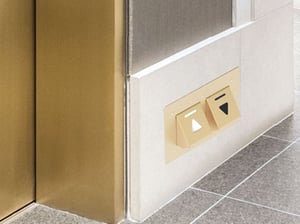Over 20,000 facilities have elevators to vertically transport occupants to their destination. As COVID-19 continues to plague our cities, balancing elevator traffic flow with social distancing requirements is critically important.
Elevators are used by millions of people every day and can carry 40 times more bacteria than public toilet seats. For elevators to remain a safe and efficient method of transportation, a clean and healthy car environment needs to be created.
The pre-COVID elevator experience goes against everything we’ve been taught about social distancing. Occupants would cram large numbers of patrons into every car. Bottlenecks would occur, especially during opening and closing hours. A pre-COVID experience is no longer an option.
One of your biggest conundrums will be how to safely transport people in elevators and manage growing crowds of people waiting in queues.
Promote Taking the Stairs
Able-bodied occupants should be encouraged to take the stairs. It’s not only a healthy option from a physical fitness standpoint, but the larger area of stairwells helps avoid the virus particles from becoming trapped in a small and enclosed space.
Some occupants will be unable to climb stairs, and others may not be able to climb dozens of stories. But if more occupants use stairwells, it will help balance elevator traffic flow and reduce bottlenecks.
Include Signage in and Around the Elevator to Reinforce Protocols
Returning to facilities in a COVID-19 world will prove challenging at first for many employees. There are a lot of new rules. Make sure you include an abundance of visuals to help remind occupants about what they should do.
- Post occupancy limits inside and outside the elevator
*Note: Some elevator IoT solutions allow you to adjust the loading parameter to limit the number of passengers allowed on the elevator to suit building needs and policies.
- Use visual floor mats to show riders where to stand and which way to face (i.e. not towards one another)
- Require masks or face coverings to limit particle aerosol spread
- Request that riders do not have conversations to reduce the number of droplets exhaled
- Remind patrons not to touch any surfaces while waiting
- Provide tissues, wipes, or other disposable items for riders to push buttons and remind them to let one person manage the control panel, if possible
- Alert occupants to the proper method of washing hands and suggest that everyone wash hands or sanitize once they leave the elevator

Install Sanitation Stations Around the Building, Especially on Every Floor Outside the Elevator Doors
Elevator buttons are high-touch areas and can gather a lot of germs. They will need to be wiped down and disinfected on a routine basis.
Sanitation stations outside the elevator doors allow you to recruit the assistance of every rider to do their part. Include helpful items for occupants to easily use while waiting in the car.
Encourage occupants to create a new process for themselves that involves:
- Sanitizing their hands once they exit the elevator
- Using personal device wipes on their belongings before entering the office area
- Before and after each ride, use disinfectant wipes to wipe down the buttons and keypads
- Reducing germ spread by using disposable tissues or wipes to push buttons and open office doors
"When there is the risk of disease spreading from human to human, continuing to maintain a clean and safe vertical transportation system is critical to help people return to work and safe living,"
- Jon Clarine, head of digital services at TK Elevator.
Consider Installing New Technology
Recently created technologies can help with the health and safety of your elevator system. There are many options that can maintain a limit on riders, reduce stops and eliminate touchpoints.
- Foot-activated elevator call buttons can help prevent community germ transmission with a touchless way of operating your elevators
- Elevator software updates offer IoT solutions to limit the weight allowed on the elevator and reduce floor stops
- Sabbath service mode settings make the elevator automatically stop at every floor and will eliminate the need for riders to push any buttons
- Ultraviolet-light disinfection systems sterilize pathogens in between the unloading and loading of tenants
- Other product offerings in the works include calling the elevator via cellphone, antiviral stickers for elevator buttons, lobby concierge-run elevators, express service for each elevator ride, and even elevator buttons that riders can activate with facial recognition, their voice, or hand gestures.
Install a Car Air Purifier
After someone sneezes, coughs, or speaks loudly, COVID-19 can remain airborne for up to 3 hours and stay on steel and plastic for up to 3 days. Air purifiers for elevator cars not only provide pollution-free air but also block and filter germs.
- A dual filter can filter the car air, remove bacteria and other harmful substances in the air, and make the car air cleaner.
- An ultraviolet-light purification system will emit germicidal irradiation lights during its filtering process. The process has killed COVID-19 in tests.
Stagger Entering and Leaving Times
Since most of the elevator traffic occurs in the morning and in the evening, offers employees the ability to change their schedule. Allow staff to enter earlier or later and try to keep them at least 15 minutes apart to avoid overcrowding.
Elevators have become a source of anxiety and can pose some real health risks during COVID-19. As you reopen responsibly, you will need to introduce new protocols that limit occupancy and require additional safety measures to be taken.
What are you doing to stay open responsibly? Please comment below with the ways you are making your facilities safer.
If you need help at your facility, Flagship can help you stay open responsibly. Our PUREClean service program provides a four-pronged approach that will help you protect employees in their workplace. Email a facilities expert today and get the help you need.





Leave a Comment